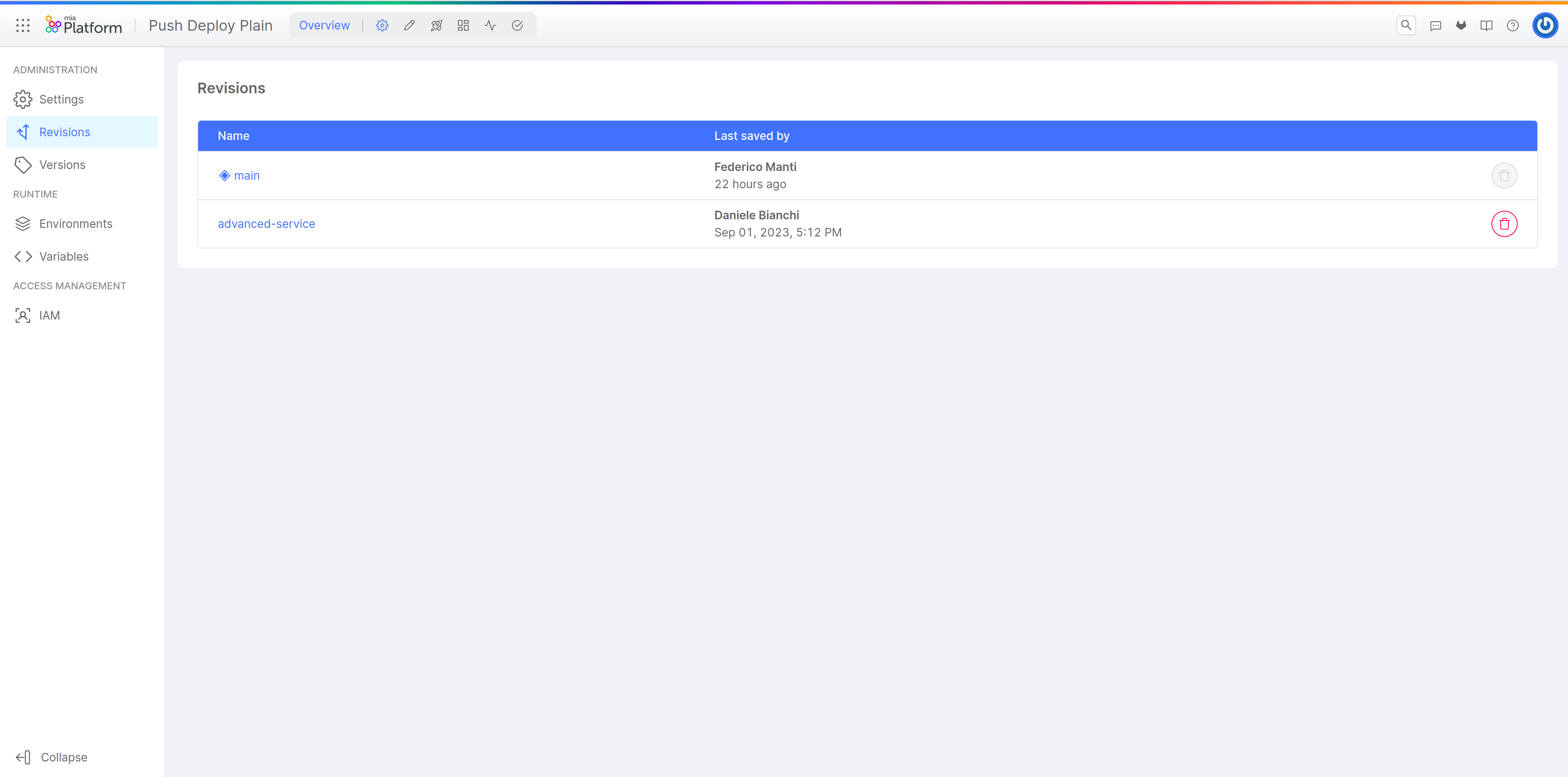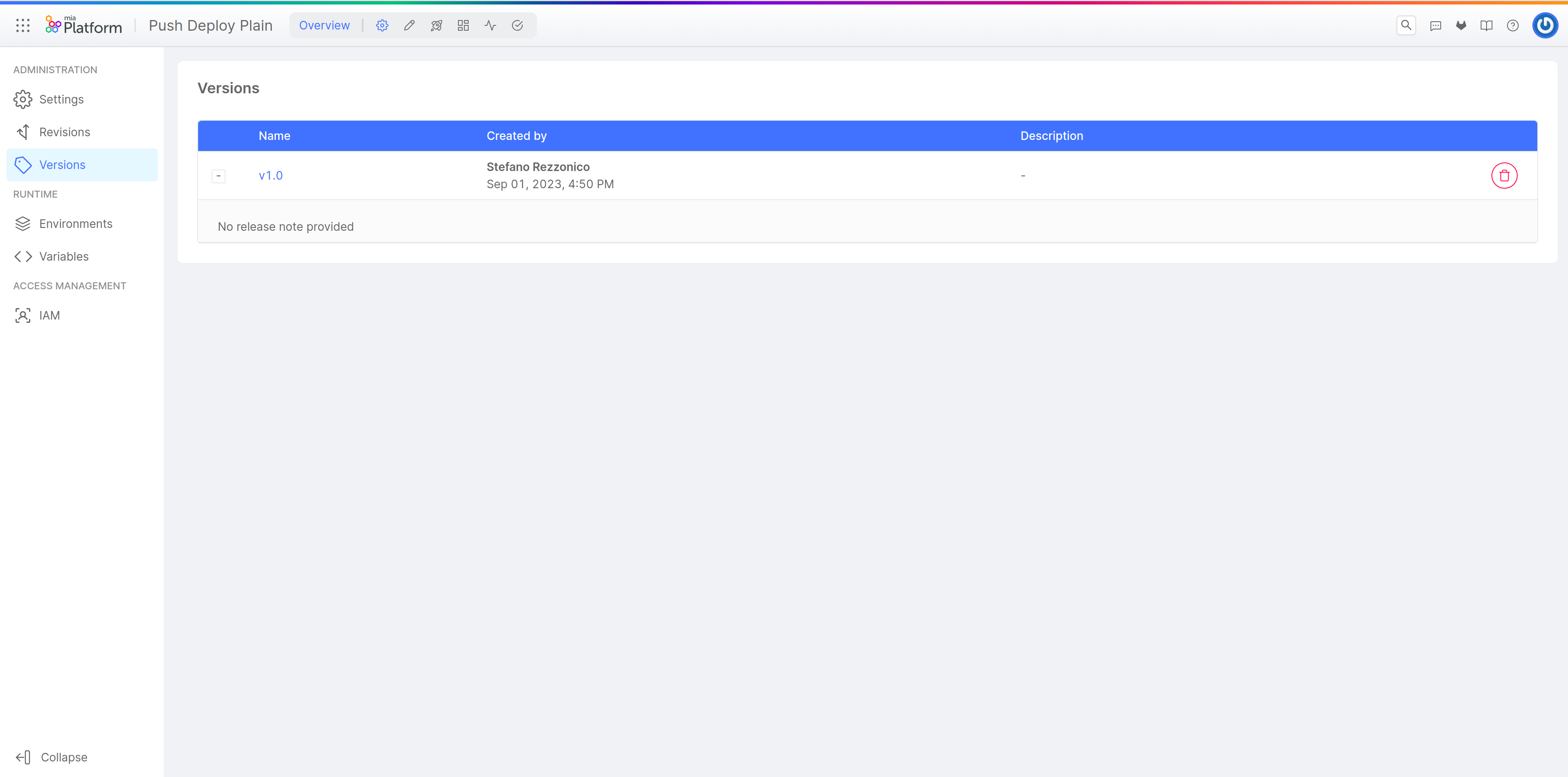Enhanced Project Workflow
This is a BETA feature and, as such, is currently under active development. Pay attention using it.
The feature is available in INTERNAL PRIVATE BETA since Mia-Platform Console v11.6.0, if you want to enable it please contact your Mia-Platform referent.
The Enhanced Project Workflow feature aims to provide a better developer experience when working with the Console, as well as pave the way for the adoption of previously unavailable opportunities, such as the GitOps deployment strategy.
Changes to the Console workflow
The following sections will highlight the changes made to the established Console workflow, regarding in particular the new management of the Project logical state, and the new deployment workflow.
New configuration management strategy
The most relevant change in the Console behavior is that the Project logical state will not be saved on your Git repository anymore. This results in significant performance improvement during the main Console workflows (especially in the Design Area), since contacting the Git provider implied a considerable overhead that has now been completely removed.
This change also means that the Console will not rely on the typical Git-based instruments anymore and will instead adopt a new configuration management system, while still maintaining consistency with the established workflows; to emphasize this, the following features have been renamed:
branchesandtagsbecomerevisionsandversions- the
commit historybecomesversion history
To keep track of the Project evolution, user can create versions (similar to Git tags) that act as fixed snapshots of the configuration in a particular moment.
Developers can manage revisions and versions from the dedicated sections inside the Overview area. Revisions can be accessed and deleted from the Revisions management page:

Versions with their description and release note can be viewed and deleted through the versions management page:
Versions can only be deleted by Project Administrators.

New deployment workflow
Another significant change is the way Console configurations are saved and deployed: Kubernetes configurations will be generated and committed to the Git repository only during the deployment process.
When deploying your configurations to the cluster, keep in mind that only the changes pushed to the repository default branch will be considered.
If you want configuration to be committed on a different branch you can change the repository.configurationBranch property in your Project configuration (currently available only from CMS).
When Kubernetes configurations are generated, they get tailored for the specific environment you are deploying to. For this reason, Public Variables interpolation is now performed during configuration generation and, as such, can be skipped during the deployment pipeline. Therefore, the Public Variables feature is now available even to Projects that are not using mlp or have a pipeline that does not support running custom code to execute variable interpolation.
The new deployment workflow also unlocks the possibility to adopt a pull-based deployment strategy, in which a GitOps tool can be set up to automatically align the cluster state to the latest changes pushed to the Git repository. To find out more about pull-based deployment and its advantages, visit the GitOps deployment strategy documentation page.
Kubernetes configuration review and export
This workflow enables users to review and export generated configurations before these are even deployed to the cluster.
This feature is available from the Deploy Page after selecting the revision to deploy.
Roadmap and future improvements
The following features are still in development and will be available in future releases.
Improvements to Project Settings
As of today, some Project customizations can be performed only through the backoffice:
- The repository default branch can be changed by updating the
repository.configurationBranchproperty. - The Project deploy strategy (useful to configure whether your Project is supposed to use a Pipeline-based or GitOps-based deployment approach) can be found in the
deploy.strategyfield for the global configuration that is inherited by all environments; to add environment specific settings you can patch theenvironments[_].deploy.strategy.
In the future, these properties will be managed in the Console, inside the Project Settings page.
Compare Kubernetes configurations with those running in the cluster
With this feature Users will be able to not only review the configurations but also compare the differences with what is currently running in the cluster and understand the impacts the deploy will have before performing it.
Migration support with automatic tools
With the first release of this new Workflow, existing Projects will require a migration operation to be performed. With this improvement we ought to provide further assistance in the migration process to make it as easy and smooth as possible.
Activating the feature
In order to activate the feature on a Project or Company, please open a service request and ask for the support of a Mia-Platform referent.
The Enhanced Project Workflow can be activated by enabling two different feature toggles. This operation can be performed by your Mia-Platform referent, who will choose the option that most fits your needs.
The ENABLE_CONF_GENERATION_ON_DEPLOY feature toggle activates the new versioning system and the generation of Kubernetes configurations at the time of deployment. It can be enabled for a single Project or for an entire Company, which means all projects in the Company, old and new ones, will adopt the new workflow.
If you already have a Company with some projects, and you do not wish to migrate them to the new approach just yet, you can choose the ENABLE_CREATE_PROJECT_WITH_SAVE_CONFIG_ON_DEPLOY feature toggle, to be activated on the Company. This feature toggle makes sure that all new projects in the Company will be created with the new workflow, while leaving the existing ones untouched.
If both feature toggles are enabled, ENABLE_CONF_GENERATION_ON_DEPLOY will prevail.
Migrating your projects
The migration process for an existing Project is currently completely manual and impacts several entities.
The process can be summarized with the following steps:
- Git repository structure clean-up
- Feature activation
- Default revision setup and adjustment of a few Project Settings
Git Repository adjustments
With the new Workflow we changed the way Console organizes the Git repository.
Previously Console supported two different folder structures based on whether the Project used kustomize or not.
With the new workflow Console uses a single common structure for both the cases. This structure contains the following directories:
environments: this one is automatically generated by the Console and contains one directory for each environment. Here are stored all the configurations files generated at each deploy.configuration: contains your global customization files to be applied to all environments. If the Project useskustomizethere will be also akustomization.yamlmanifest file.overlays: containing one directory for each environment. Here all your environment-specific patch files are stored, as well as akustomization.yamlmanifest if you are usingKustomize.
The final repository structure should be similar to the following:
├── overlays
│ ├── dev
│ │ └─── <dev custom file>
│ ├── production
│ │ └─── <prod custom file>
│ ├── other_env_id
│ │ └─── <env_id custom file>
│ └── ....
│
├── configuration
│ └─── <global custom files>
│
├── environments
│ ├── dev
│ │ └── <k8s config files>
│ ├── production
│ │ └── <k8s config files>
│ ├── other_env_id
│ │ └── <k8s config files>
│ └ .....
All the contents of the environments directory are generated from scratch each time, any additional file that is not managed by the Console will be overwritten!
The migration process for the git repository differs depending on whether the project is using kustomize or not. Follow the right section for your Project to correctly update the git repository:
- Plain
- Kustomize
Edit overlays/:environmentId/kustomization.yml file and replace the path ../../configuration with ../../environments/:environmentId.
When generating the environments/:env/kustomization.yml, the Console will automatically import the configuration/kustomization.yml if present.
Your kustomization.yml file should look like this:
apiVersion: kustomize.config.k8s.io/v1beta1
kind: Kustomization
resources:
- ../../environments/dev
Within the configuration folder you have to delete all the k8s configuration files previously handled by the Console. Leaving only the kustomization.yml and your custom files (if any).
Create a folder named overlay and one subfolder for each environment of the Project. These subfolders should be named using the environment Id.
To do this, you can refer to the example structure just above.
Move every k8s configuration file from the configuration/:envId to the relative directory just created inside the overlays folder.
The configuration folder should then contain only global customization files (if any).
Other common cleanup for git repository
If you have a pipeline file (e.g.
gitlab-ci.yml) it may contain deployment scripts that may work based on the previous directory structure. For this reason, custom pipelines have to be updated according to the new directory structure; if your Project is using a pipeline provided by Mia-Platform templates, a new template can be used: please ask your Mia-Platform referent to know which one.All the Console configuration state files and directories that were previously saved on Git can now be safely removed.
Here is a list of the files and directories that can be deleted:api-console-config.jsonfastdata-config.jsonmia-craft-config.jsonrbacManagerConfig.jsonbackofficeConfigurations.jsonconfig-mapsconfig-extensionvariablesoverlays/:env/variables.env
Feature Activation
To activate the feature, follow the instructions in the dedicated section. If you wish to activate the feature on a single Project, proceed with enabling the ENABLE_CONF_GENERATION_ON_DEPLOY feature toggle on the specific Project rather than on the whole Company.
Project Settings configuration
After activating the Feature, ensure to configure the new default revision field from the Project Settings selecting one of the already existing branches (namely Revisions).
If no default revision is specified, the Console will use main as the default revision.
This revision will be an empty configuration if no other main branch was previously created on the Project.
Pull-based deployment strategy
If you want the Project to use a pull-based deployment strategy, its configuration must contain the strategy property set to pull (the value for push-based deployments is push). Based on the selected strategy, the runnerTool may take different values.
For now, the deployment strategy can only be set from the backoffice. Please ask the support of your Mia-Platform referent to change it.